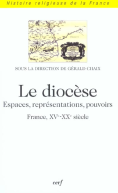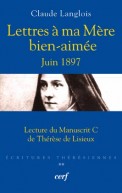
Lectures vagabondes
Collection Sciences humaines et religions
432 pages - févr. 2011
41,80€
« Vagabondes », résolument, ces lectures de Thérèse qui passent, comme à saute-mouton, du purgatoire à la morale d'intention, des angoisses d'une mère aux prises avec des saints jaloux à la consolation d'une prieure mal élue. Et la carmélite supporte fort bien ces éclairages successifs. « Lectures vagabondes » encore, par le choix d'aller du passé de Thérèse à celui des thérésiens. « Lectures vagabondes » enfin, par la variété des approches au service d'un but unique : toujours tenir les deux bouts de la chaîne, observer la femme qui écrit pour comprendre les œuvres qu'elle produit. En appréciant la manière dont l'« Œuvre complète » de Thérèse a été tôt appréhendée, Claude Langlois s'engage dans l'exploration d'un XXe siècle mouvementé entre rassemblement des écrits, au moment du Procès (1910), et production de l'édition de référence, la Nouvelle Édition du Centenaire (1992), sans oublier le rôle des hommes de pleine lumière, comme l'abbé Combes, et celui des moniales de l'ombre, comme Sœur Cécile. En réfléchissant, à nouveaux frais, sur Thérèse écrivain, l'historien de Thérèse s'oblige à faire sans cesse retour à l'œuvre produite, pour mieux articuler ses composantes (correspondance ; textes publics, théâtre et poésies ; textes personnels, ses trois grands écrits) et pour manifester comment, à la fin de sa vie, Thérèse de Lisieux a eu une claire conscience d'appartenir, à l'instar de la grande Thérèse, son modèle, à cette catégorie bien particulière de saintes qui « ont enrichi l'Église de leurs sublimes révélations ». Ainsi ces « Lectures vagabondes » couronnent-elles des « Écritures thérésiennes » consacrées à la présentation, voire à l'édition des trois écrits majeurs de Thérèse de Lisieux. Elles renouvellent l'approche des poésies, par l'intérêt porté à leur circulation du vivant de Thérèse, et des prières, par l'analyse approfondie de « l'Offrande à l'Amour miséricordieux ». Elles veulent surtout faire mieux accéder à l'unicité et à la fécondité d'une grande œuvre mise au service d'un grand dessein : Thérèse avec ses mots, usés et neufs, dessinant obstinément, jusqu'à la mort, la figure méconnue d'un Dieu miséricordieux.
--
“Vagabonds” they are indeed, these readings of Thérèse that pass, in leap-frog fashion, from purgatory to the morality of intention, from the anguish of a mother struggling against jealous saints to the consolation of an ill-chosen prior. And the Carmelite stands up very well to these successive elucidations. Lectures vagabondes again, when it passes from Thérèse’s past to that of her followers. Lectures vagabondes finally, in the variety of approaches employed in one single aim: never to lose hold of both ends of the chain, to observe the woman who writes in order to understand the works she produced. Appreciating the way in which the Complete Works of Thérèse was promptly received, Claude Langlois began an exploration of an eventful 20th century, between assembling writings at the time of the Trial (1910), producing the edition that was to be a reference: the Nouvelle Édition du Centenaire (1992), not forgetting the role played by men of light such as such as Abbé Combes, or those in the background, like Sister Cécile. By taking a fresh look at Thérèse the writer, the historian of Thérèse was obliged to endlessly return to the production, in order to better relate the elements (correspondence; public texts, theatre and poetry; personal writings, her three great texts) and to show how, at the end of her life, Thérèse of Lisieux had a clear awareness of belonging, like the great Thérèse, her model, to that very special category of saints who “enriched the Church with their sublime revelations”. So these Lectures vagabondes crown the Écritures thérésiennes devoted to the presentation, indeed the publishing, of three major works by Thérèse de Lisieux. They look afresh at the manner in which the poetry should be read, by informing readers about their circulation during the life of Thérèse; and the prayers, by deep analysis of the Offrande à l'Amour miséricordieux. But above all, the aim of this book is to help us seize the unity and the fecundity of a great work produced in the service of a great design: Thérèse with her words, familiar and new, obstinately describing – even until death - the little-known figure of a merciful God.
--
“Vagabonds” they are indeed, these readings of Thérèse that pass, in leap-frog fashion, from purgatory to the morality of intention, from the anguish of a mother struggling against jealous saints to the consolation of an ill-chosen prior. And the Carmelite stands up very well to these successive elucidations. Lectures vagabondes again, when it passes from Thérèse’s past to that of her followers. Lectures vagabondes finally, in the variety of approaches employed in one single aim: never to lose hold of both ends of the chain, to observe the woman who writes in order to understand the works she produced. Appreciating the way in which the Complete Works of Thérèse was promptly received, Claude Langlois began an exploration of an eventful 20th century, between assembling writings at the time of the Trial (1910), producing the edition that was to be a reference: the Nouvelle Édition du Centenaire (1992), not forgetting the role played by men of light such as such as Abbé Combes, or those in the background, like Sister Cécile. By taking a fresh look at Thérèse the writer, the historian of Thérèse was obliged to endlessly return to the production, in order to better relate the elements (correspondence; public texts, theatre and poetry; personal writings, her three great texts) and to show how, at the end of her life, Thérèse of Lisieux had a clear awareness of belonging, like the great Thérèse, her model, to that very special category of saints who “enriched the Church with their sublime revelations”. So these Lectures vagabondes crown the Écritures thérésiennes devoted to the presentation, indeed the publishing, of three major works by Thérèse de Lisieux. They look afresh at the manner in which the poetry should be read, by informing readers about their circulation during the life of Thérèse; and the prayers, by deep analysis of the Offrande à l'Amour miséricordieux. But above all, the aim of this book is to help us seize the unity and the fecundity of a great work produced in the service of a great design: Thérèse with her words, familiar and new, obstinately describing – even until death - the little-known figure of a merciful God.
- Dimensions : 135x215x30
- ISBN : 9782204093309
- Poids : 550 grammes
DU MÊME AUTEUR
> VOIR TOUS LES LIVRES DE l'AUTEUR










